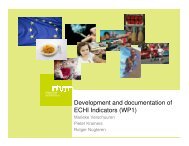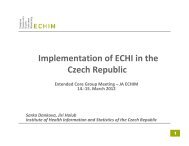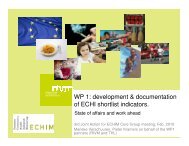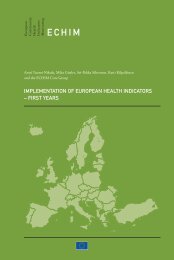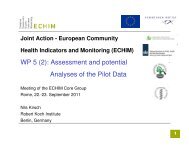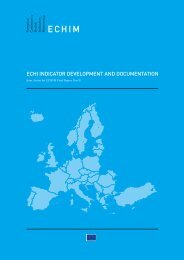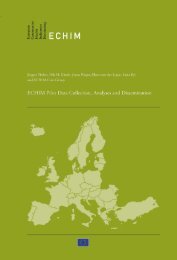INDICATORS
ECHIM Final Report
ECHIM Final Report
You also want an ePaper? Increase the reach of your titles
YUMPU automatically turns print PDFs into web optimized ePapers that Google loves.
indicators and the development of data sources must be provided to Member States.<br />
It is expected that the research and development work and the discussions will result<br />
in country specific implementation plans providing guidance to the work in Member<br />
States. Implementation will be supported by Joint Action for ECHIM affiliated experts<br />
in all EU countries. In each country the responsibility for implementation proper lies<br />
with national key persons.<br />
The need for regional implementation in many Member States must be taken into<br />
account by the project’s regional experts and in the guidelines for the use of indicators<br />
in regions (ISARE project).<br />
6.4. Developing the data flow and gathering of new indicators<br />
To obtain practical results it is essential to reshape or create data sources in each Member<br />
State, to retrieve the data, to create indicators and to transfer them to a central repository.<br />
As long as there exists no EU-wide agreement and health monitoring system, these<br />
processes must be simulated. Joint Action for ECHIM must take on the necessary tasks<br />
in order to test the data and their sources as well as the transfer, analysis and dissemination<br />
system. Therefore as part of the implementation and development process the major<br />
tasks ahead are 1) to design the data flow (gathering, quality assurance, storage, analysis<br />
and dissemination) from Member States to a central health monitoring capacity, 2) to<br />
take into account existing arrangements in Member States, in EU bodies (Eurostat and<br />
other DGs, European institutes, such as ECDC) and other international organisations<br />
(OECD, WHO), 3) to carry out pilot tests of data flow with several Member States, 4)<br />
to persuade and support Member States in applying the proposed design, binding central<br />
EU activities with those in the Member States, 5) to retrieve the first newly implemented<br />
indicators, 6) to present a tabulation and conclusions based on that tabulation and 7)<br />
to continue to participate in the development and implementation of indicators. The<br />
plan for the design of the data flow will be discussed in particular with DG SANCO,<br />
Eurostat, the WHO Regional Office for Europe and the R&D unit at THL. The plan<br />
includes setting up a temporary server for testing the data flow, if necessary. This server<br />
will be used to gather data from as many Member States as possible, to enable quality<br />
assessments and, finally, to tabulate, analyse and publish the information on current and<br />
new indicators. This work will result in a first extended Health Report for Europe.<br />
The development phase, including data transfer and dissemination, must be kept<br />
as streamlined as possible and remain in the control of the Joint Action, including<br />
the Member States. Therefore, the Commission, i.e. DG SANCO and Eurostat,<br />
will collaborate with Joint Action for ECHIM but will not be directly involved in<br />
administering and running the development work. However, it is necessary to maintain<br />
close collaboration with them. In the long run it is intended that a permanent EU<br />
72



